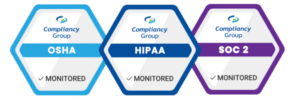How to Become OSHA Compliant
You might be wondering, what is OSHA compliance? The federal Occupational Safety and Health Act, known as “OSHA,” or the “OSH Act,” requires employers of all sizes to comply with the law’s safety standards. These standards address hazards in the workplace, and how to minimize employee exposure to these hazards.
The greater this exposure can be minimized, the greater the chance of employee injury on the job is reduced. OSHA requires that employers provide their employees with working conditions that are free of known dangers. The Act created the Occupational Safety and Health Administration (OSHA), which sets and enforces protective workplace safety and health standards. OSHA also provides information, training, and assistance to workers and employers. The issue of how to become OSHA compliant is discussed below.
How to Become OSHA Compliant: Does OSHA Apply to My Business?
The OSH Act covers most employees in the U.S. OSHA covers private sector employers and employees in all 50 states. Employers are covered either directly through the federal OSHA law and Occupational Safety and Health Administration, or through a “State Plan.” Roughly 40% of the states have their own OSHA “State Plan.” These OSHA-approved safety programs must provide for at least as much safety protection to employees as federal OSHA does.
How to Become OSHA Compliant: What Must I Provide My Workforce?
To help ensure a safe and healthful workplace, OSHA also provides workers with certain rights. Employers must allow employees to exercise these rights, without retaliation.
◈ Receive, from their employer, information and training about hazards, methods to prevent harm, and the OSHA standards that apply to their workplace. The training must be in a language that employees can understand.
◈ Observe testing that is done to find hazards in the workplace, and obtain copies of test results.
◈ Review records of work-related injuries and illnesses.
◈ Get copies of their medical records.
◈ Request that OSHA inspect their workplace.
How to Become OSHA Compliant: OSHA Standards
OSHA standards are rules and regulations. Standards describe the methods employers must use to protect workers from hazards. There are OSHA standards for each of the following industries: agriculture, construction, maritime, and general industry. The first three of these industries are specialized industries in which the risk of worker injury is relatively high. General industry, the fourth industry, comprises most businesses in America, and includes, for example, medical offices, dental offices, and specialist offices.
Each industry must follow a specific set of standards. General industry, for example, must follow the Hazard Communication Standard (which requires employers to make employees aware of hazardous chemicals in the worksite, and provide protection from exposure to these chemicals); the bloodborne pathogens standard (which requires employers to implement measures minimizing the risk that employees will be exposed to blood or other potentially infectious materials); the Fire Prevention Plan Standard (which requires employers to develop a fire safety plan to instruct employees on how to prevent fires from occurring, and how to respond to fires that break out).
Standards require employers to use certain safe work practices and equipment; to monitor hazards; to provide personal protective equipment (PPE), such as gloves and respirators, and to report workplace injuries.
Employers must also comply with the “General Duty” Clause of the OSH Act. The General Duty Clause is a “catchall” provision. It requires employers to keep their workplaces free of serious recognized hazards, even when no particular standard applies to the hazard.
OSHA standards are rules that describe the methods that employers must use to protect their employees from hazards. There are OSHA standards for construction work, maritime operations, and general industry, which is the set that applies to most worksites. These standards limit the amount of hazardous chemicals workers can be exposed to, require the use of certain safe practices and equipment, and require employers to monitor hazards and keep records of workplace injuries and illnesses.
Employers must also comply with the General Duty Clause of the OSH Act, which requires employers to keep their workplace free of serious recognized hazards. This clause is generally cited when no OSHA standard applies to the hazard.
How to Become OSHA Compliant: Additional Employer Responsibilities
Employers, as part of the duty to provide employees with a workplace that does not have serious hazards, must find and correct safety and health problems. OSHA further requires that employers have to try to eliminate or reduce hazards first by making changes in working conditions rather than just relying on masks, gloves, ear plugs or other types of personal protective equipment (PPE). These changes in working conditions include engineering controls (measures, such as ventilation systems, designed to eliminate a hazard) and work practice controls (requiring employees to wash their hands, requiring employees work in flexible shifts, and requiring employees work only in designated areas). If (and only if) these methods do not work, employers must provide employees with personal protective equipment, which employees must use to minimize their exposure to hazards.
To be OSHA certified employers MUST also:
◈ Provide hearing exams or other medical tests required by OSHA standards; and
◈ Post OSHA citations, injury and illness data, and the OSHA poster in the workplace where workers will see them.







